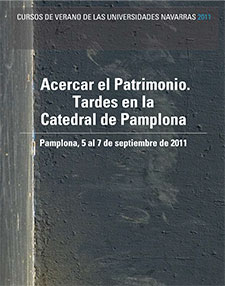BRINGING HERITAGE CLOSER. EVENINGS IN PAMPLONA CATHEDRAL.
6 September 2011
Artists in the Cathedral. Esteba de Obray, master of choir stalls.
Ms. María Concepción García Gainza. Chair de Patrimonio y Arte Navarro.
The Italian Renaissance is introduced in the Cathedral of Pamplona by the activity of a French master who made the choir stalls of the cathedral choir in which Humanism makes its first appearance in this temple.
Esteban de Obray, born in Saint-Thomas, bishopric of Rouen, is part of the numerous group of Frenchmen who settled in the peninsula spreading what has been called the "French way" or a "French Renaissance", and who introduced in the early 16th century the not very pure Italian Renaissance, less canonical in its projects than the Tuscan or the Lombard, but with the same decorative fervor. The case of Philip Vigarny in Castile, Gabriel Joly in Aragon or Esteban de Obray in Navarre show the definitive role played by these Frankish masters in the introduction of the Renaissance in the different regional schools. They maintained artistic relationships among themselves and settled in our country where they were highly regarded artistically.
Obray enjoyed the protection of Don Pedro de Villalón, dean of Tudela and Santa María de Calatayud, who commissioned him the choir stalls of the Tudela cathedral. Obray was not the Renaissance master that Villalón, who had belonged to the circle of Julius II in Rome, could have wished for, but he was an excellent master ashlar maker who executed the Tudela choir stalls (1517-1522) with the help of Frankish masters in a flamboyant-Gothic style like the Aragonese stalls of San Pablo de Zaragoza or San Pedro el Viejo de Huesca, but with advances towards the Renaissance already fully manifested in the grille that closes the Tudela choir.
In the stalls of the Cathedral of Pamplona (1539-1541) promoted by the prior Sancho Miguel Garcés de Cascante, who had also been in Rome, Obray will advance decidedly towards the Renaissance, developing in addition to a sacred program an ornamental repertoire "to the Roman" in which the gods and heroes of Classical Mythology are not lacking. Christianity and Humanism are thus offered in perfect symbiosis.
Finally, in the stalls of the temple of El Pilar in Zaragoza (1542-1548) the Italian component is intensified with the participation of the Florentine Juan de Moreto and the Italian painter Tomás Peliguet, who would contribute his figurative designs for the composition of the scenes.

Detail of the choir stalls of the cathedral of Pamplona. 1539-1541
PROGRAM
Monday, 5th September
The Cathedral in the History of Navarre: the cathedral, the chapter, the institutions and the bishop.
D. Luis Javier Fortún Pérez de Ciriza. Royal Academy of History
Capitals and keystones of the Cloister of Pamplona Cathedral. That unknown world
Ms. Clara Fernández-Ladreda Aguadé. University of Navarra
Travellers' views of Pamplona Cathedral
Ms Carmen Jusué Simonena. UNED of Pamplona
Tuesday, 6th September
Sumptuary arts in the Cathedral
D. Ignacio Miguéliz Valcarlos. Chair of Navarrese Heritage and Art
Artists in the Cathedral. Esteban de Obray, master of choir stalls.
Ms. María Concepción García Gainza. Chair de Patrimonio y Arte Navarro
A stroll through the canonical dependencies of the cathedral
Mr Javier Martínez de Aguirre. Complutense University of Madrid
Duplicate visits to the cathedral complex in Pamplona
Wednesday, 7th September
Golden scenery: the baroque altarpieces
D. Ricardo Fernández Gracia. Chair of Heritage and Navarrese Art
The cathedral today and tomorrow: projects in progress
D. Francisco Javier Aizpún Bobadilla. Episcopal Vicar for Heritage. Archbishopric of Pamplona
CLOSING: Concert at position Choir Santa María la Real de Voces Graves

